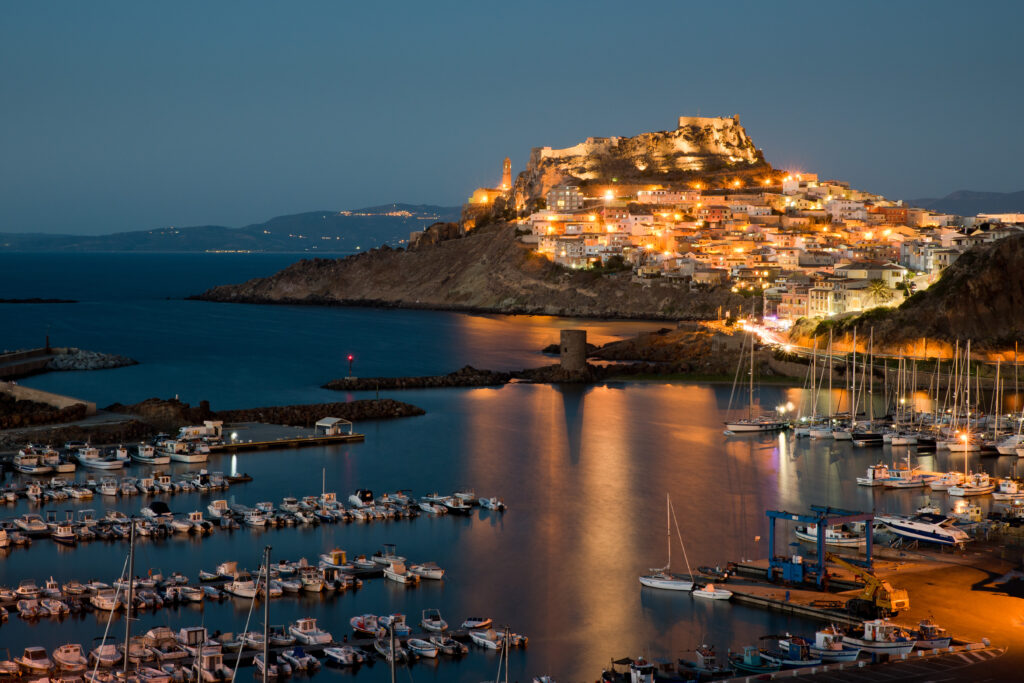Sardinia (Sardegna in Italian) is the second-largest Italian island and is situated in the middle of the Mediterranean Sea. The Greeks called it Hyknusa or Ichnussa (Ιχνουσσα), from the Greek ichnos (footprint of the human foot) because of its resemblance to a large footprint; Sardinia, however, takes its name from the Latin Sardinia, as the Romans called it. In fact, the Sardinian toponym was already known to the Phoenicians, as evidenced by the Stele di Nora, the oldest written western document found in Sardinia, in Nora.

With its 1840 km of coastline, it is the Italian region with the longest coast; the sea is clear and practically preserved from any kind of pollution. Many beaches in Sardinia are now well known nationally and internationally, such as those of Villasimius, the Costa Smeralda, and Alghero, and are among the favorite destinations for holidays. Many others, however, just as beautiful, have managed to preserve their wild nature, entirely or partially escaping mass tourism. This is the case of Berchida beach, some beaches of Ogliastra or the province of Oristano.
Ancient Sardinia
Being such an ancient land, Sardinia does not have very high peaks due to the erosion of winds and rains; it is predominantly mountainous, characterized by plateaus and hills.
There are also numerous historical and archaeological sites in the region; the most famous is the Nuraghi: there are 7,000 scattered throughout the island. They represent the most impressive megalithic monuments in Europe. Nuraghi, menhirs, sacred wells, tombs of the giants and “Domus de Janas.” have made the Sardinian scenery unmistakable.
Sardinia is also called “the other Continent,” a continent that has been there at the center of Western civilization for millennia and is still at its margins, remote, independent and timeless.
The Way Of The Sardinian
However, what makes this grand island so unique is “Sardità” and its intrinsic meaning: the inhabitants consider themselves Sardinians, even before to be Italians. The Sardinians themselves are not talkative people. Nor are they theatrical like other Italians. You will hardly find a Sardinian then obsequious. They are also famous for being stubborn, traditionalists up to excess, generally modest in their behaviour, but touchy and very protective of their right name and dignity.
Many consider Sardinia the “least Italian” among all the regions: the geographical isolation has, in fact, allowed the development of native animal and vegetable species (such as the moufflon or the white donkey of the Asinara), and has safeguarded its linguistic peculiarity and its ancient traditions, which have remained intact over the centuries.
A History Of Invasions
The island, far from being small and marginal, has always been a crossroads of economic and cultural exchanges among peoples since ancient times; belonging to the continent, in fact, is only geographical: historical, geological, social and economic peculiarities place the island on an entirely different level than in Italy. On school books – in which Sardinia really occupies a marginal place – people study that the Sardinians have always been dominated, but this does not correspond to the truth: they have simply adapted, bent, genuflected to the powerful of turn, being content to collect the crumbs enough to make a living. The Sardinians were in fact dominated, in order, from the Carthaginians, Romans, Byzantines, Pisans and Genoese, Spaniards, Piedmontese.
Italy And Sardinia
The differences between Sardinia and the Italian peninsula are still evident despite a century and a half of cultural Italianization (and despite globalization tends to flatten diversity): basically, the main things in common are language and television. A Sardinian and an Italian both speak Italian, but the culture and mentality expressed with this language are different.
This is not to say that there is not some cultural closeness between Sardinia and Italy, which obviously exists, but only that in the same way Sardinia has traits of cultural commonality with the cultures of all the peoples of the Mediterranean and of the ‘Europe; and in any case the culture most similar to that of Sardinia is that of the Iberian peninsula.
A Spanish Influence
The balance of the period of Spanish domination was certainly negative in almost all fields, but not in the cultural one, there is a real exchange and not an imposition. Many of the most beautiful expressions of Sardinian culture date back to this period and are the result of the reworking of Iberian models in an absolutely original Sardinian key (eg the thousands of small churches of that period, real little jewels; traditional clothes; the lexicon of the same language that contains an infinite number of Spanish terms).
A Rich Culture Survives In Sardinia
The heart of Sardinia beats around the Gennargentu mountain massif and the Supramonte plateau. Since the island entered the orbit of Carthage expansion, Barbagia – composed of several historical regions that belong almost entirely to the province of Nuoro – is a place of resistance to invasions and preserves centuries-old traditions. Events, customs, and claims are told by the murals that decorate its villages, Orgosolo in the first place.
Popular dances, singing, embroidered dresses, filigree jewels, colorful carpets, baskets, cowbells, inlaid knives and, for gastronomy, “pani pintau” (decorated bread), delicious cheeses, “su filindeu” (fresh pasta from eaten in sheep broth) and sweets.
The best opportunity to get acquainted with the ancestral pastoral rites, connected to the cycle of death and rebirth of nature, is the exuberant Barbagia Carnival, populated by often disturbing costumes that symbolize the encounter-clash between animal and man, instinct and reason, winner and won, good and bad. The most famous protagonists are the “Mamuthones” and “Issohadores” of Mamoiada.
Festivals Play A Huge Role In Sardinia
Festivals have always marked the life of island communities, and in modern times, they are linked to the desire to reaffirm their unique cultural identity. In Sardinia, going for parties means immersing yourself in an ancient culture to discover unknown sounds and harmonies, rhythmic dances with vibrant traditional costumes, poetic competitions out of time, wild horse races, folkloric parades with precious and colorful dresses of other times.
Feasts often last several days and involve the whole community; many times, for the occasion, unique desserts are prepared and organized banquets with traditional dishes to which everyone can participate.
Even traditional Sardinian music, both sung and instrumental, is ancient. In a vase dating back to the culture of Ozieri, about 3,000 years BC, they depict dance scenes. The characteristic Sardinian dance called “su ballu tundu” is accompanied by the sound of “launeddas,” an ancient instrument consisting primarily of three canes and played with the technique of continuous breath. The origin of the “launeddas” is traced back to an era before the eighth century BC
The “Canto a tenore” singing is typical of the inland areas of Barbagia and is considered a peculiar and unique artistic expression in the world. The first testimony could date back to a 7th century BC small bronze statue where a singer is depicted in the typical tenores pose. The song in its current form is the result of the encounter with the local melodic traditions with the guitar brought to Sardinia by the Spanish. This song has had a significant diffusion since the twentieth century thanks to the numerous village festivals during which real competitions are held between cantadores, generally male, accompanied by a guitarist and often also by an accordionist.
With bright colors and the most varied and original shapes, traditional costumes represent a clear symbol of belonging to specific collective identities. They are considered a treasure chest of ethnographic and cultural traditions with very peculiar characteristics. Although the basic model is homogeneous and universal throughout the island, each town has its own traditional male and female clothing, which differentiates it from other cities.
In the past, clothes also diversified within the communities, carrying out a precise communication function as they immediately made clear the registry status and the role of each member in the social sphere, the historical region or country of belonging, a special civil status.
Sardinia Is A Unique Place Full Of Mystery
The uniqueness of Sardinia and its population is also witnessed by a peculiarity: an international research team has discovered that in the modern Sardinian population the DNA of ancient hunter and gatherer populations survives, which lived on the island 12 thousand years ago. This is an exceptional discovery that underlines the uniqueness of the genetic heritage of the inhabitants of Sardinia, linked to the isolation that has lasted for millennia.
Moreover, Sardinia is known as one of the 5 countries in the world with the highest number of centenarians, together with the village Loma Linda (in California), the peninsula of Nicoya (in Costa Rica), the island of Ikaria (in Greece) and Okinawa (in Japan). But what is this peculiarity due to? In reality, there is no definite answer to this question. Some scientists believe that the secret lies in the genetics of DNA, others in daily habits, and others in a particular diet.
Last but not least, unlike continental Italy, Sardinia has always been considered a land with low seismic risk. If, in fact, the entire Italian peninsula is on the line of contact between the African Plate and the Eurasian plate, Sardinia appears to be excluded. Since the earthquakes generated by the reciprocal movements between the plates as mentioned above, and being Sardinia outside of this fracture line, it follows that it is a land relatively immune to seismic phenomena.
Is Sardinia A Country? – Read The Article
Where Is Sardinia? – Read The Article
Is Sardinia Expensive? – Read The Article
Unusual Places To Visit In Sardinia – Read The Article
